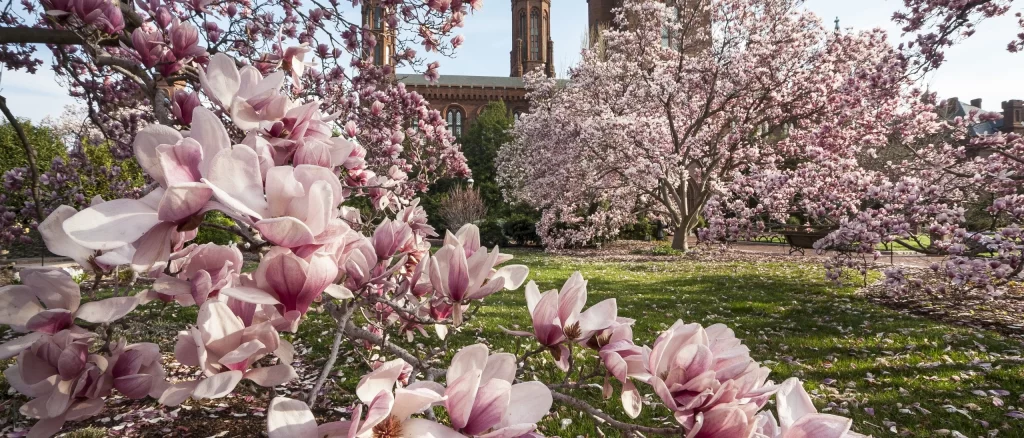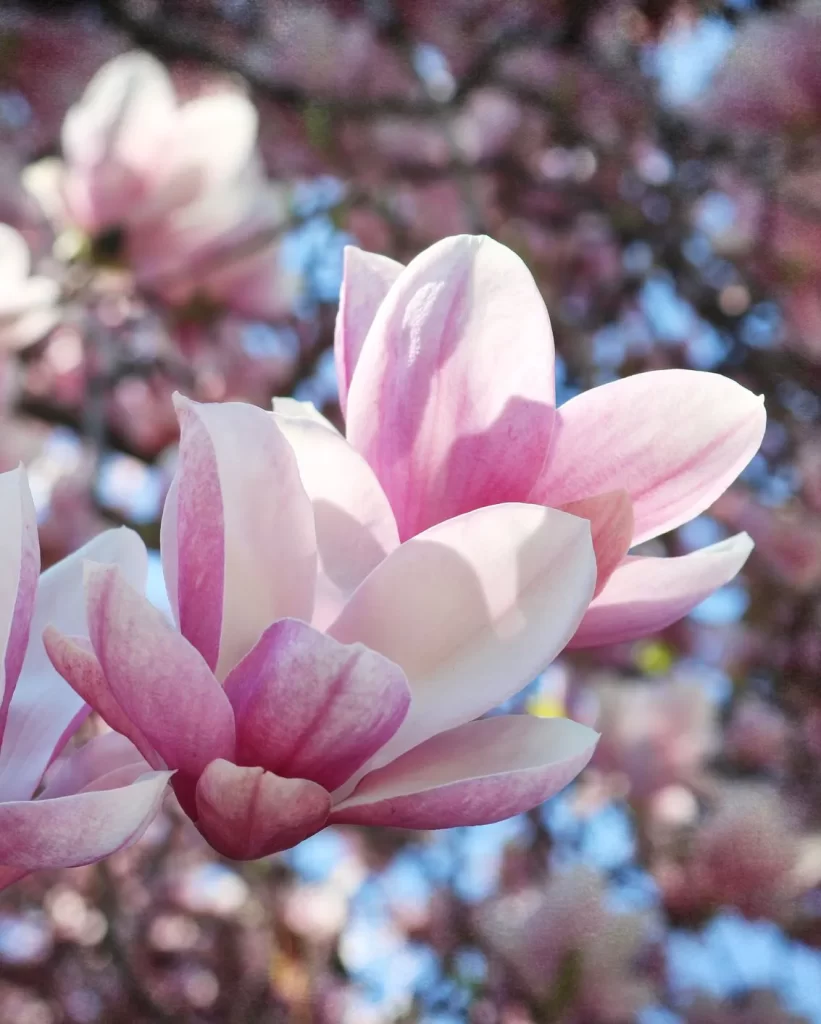The Magnolia (Magnoliaceae) is a blooming plant that has been around for a long time; its fossil records show that it has been there for more than 95 million years, making it one of the oldest flowering plants ever discovered. In that time, it has diversified into over two hundred species, each with its own set of characteristics but all sharing the distinctive, irresistible allure that makes the magnolia a plant unlike any other.
Magnolia grandiflora, aka Southern magnolia
The magnolia, the genus for which was named after the French botanist Pierre Magnol, has an incredible range of diversity. Their huge, bright flowers, which may be a foot in diameter, are a visual and sensual feast. As they open, they show a complex design of petals and release a fragrant aroma that is sure to captivate. Large, fragrant blooms of white, yellow, pink, or purple, as well as the often-attractive foliage and peculiar fruits, are the plants’ most prized characteristics. Not only do some make for stunning decorative trees in the landscape, but others provide much-needed lumber.

Attributes of Magnolia
A Botanical Beauty: Understanding Magnolia
| Common Name | Magnolia, saucer magnolia, tulip magnolia, Southern magnolia |
| Botanical Name | Magnolia |
| Family | Magnoliaceae |
| Plant Type | Tree and shrub |
| Mature Size | 20-80 ft. tall, 20-40 ft. wide |
| Sun Exposure | Full, partial |
| Soil Type | Moist but well-drained |
| Soil pH | Acidic, neutral, alkaline |
| Bloom Time | Spring, summer |
| Flower Color | Pink, white, yellow, purple |
| Native Area | North America, Asia |
The botanical qualities of the magnolia contribute to its appeal. The magnolia is a miracle of botany because of its many distinctive features, including its fragrant flowers, distinctive buds, and wide range of vibrant colors.

Magnificent Flowers
The blossoms of the magnolia are, without a question, the most eye-catching part of the plant. Large and colorful, the flowers of certain species of magnolia may be up to a foot in diameter. Adding a touch of sheer elegance to landscapes, these magnificent flowers are evocative of a painter’s canvas bursting with splashes of bright colors. They may be found in many shades of white, cream, pink, purple, and even yellow, each of which contributes something unique to the allure of the plant.
Read: Propagate Elephant Ear Plants: A Step-by-Step Guide
Enchanting Fragrance
Magnolia blossoms have an aroma that is just as alluring as their visual charm. Magnolia flowers have a complex, intense fragrance. Across the globe, this scent has come to represent the onset of spring and its promise of rebirth.
A Journey of Constant Evolution
The magnolia’s beauty, however, endures; it is a story of ongoing change that unfolds throughout the course of the flower’s life cycle. A development from a closed bud to an open, beautiful flower. A bract covers the developing bud to shield it from environmental hazards. These blooms have their own unique beauty, typically silky and delicately rounded, like a promise of the unfolding glory.
As the weather warms up, the bract separates and the bud grows, eventually bursting open in a spectacular show of petals. This gradual revealing of its beauty is a wonder to see, a reflection of the path many of us travel through life: from promise to actualization, from bud to flower.
The magnolia flower’s intricate design becomes apparent after it opens. The petals’ layered arrangement around the cone of carpels and stamens is both aesthetically pleasing and biologically significant. In addition to adding magnificent beauty to landscapes, flowers at their peak attract pollinators, which play an essential role in maintaining ecological balance. The petals eventually wither and fall to the ground, revealing the earthy tones underneath. This is not the end, though; rather, it is a transition into a new phase of the tree’s life cycle that promises yet another spectacular display of flowers. It’s proof of the recurrent pattern of life’s development, decline, and renewal.
The Magnolia’s Ecosystem Role
Magnolias are vital to the overall wellbeing of their ecosystems and help maintain a delicate equilibrium. Flowers and trees feed animals and other plants throughout their entire life cycles, from pollination through leaf fall.
Magnolia as a Food
Magnolias play an important function as food sources in their ecology. Pollinators of all kinds depend on their huge, nectar-filled blooms for sustenance. Despite their ancient ancestry, beetles, not bees, are responsible for most magnolia pollination. Another example of the magnolia’s resilience is the beetles’ ability to collect nectar and pollen using a less delicate manner that is well-suited to the blossoms’ sturdy, robust architecture.
In addition to providing sustenance for pollinators, magnolia trees also provide food for a wide range of birds and animals, which in turn aids in seed dissemination. Their dead leaves provide a safe haven and food for a wide variety of insects and microbes, and they also improve the soil as they degrade.
Habitat Providers
Magnolias are important since they not only give shelter but also food. A wide range of birds and small animals find refuge in the sturdy structure and expansive canopy of mature magnolia trees. These trees are important because they are used as nests and offer cover from predators, both of which contribute to the health of the local ecosystem.
Magnolias are vital to their respective environments because to their physical and ecological resilience. Because of their durability and endurance, they may stay put in the same spot for a long time, giving the ecosystem reliable long-term sustenance. Their adaptability to different environments also promotes the overall health of ecosystems.
Threats to Magnolia
Despite being hardy and resilient by nature, Magnolias confront serious challenges in the contemporary world. Many Magnolia species are threatened by human activities like as habitat destruction, global warming, and overexploitation, thus it is imperative that we work to preserve them for future generations.
Habitat Loss
The destruction of Magnolias’ natural habitat is a major problem. The natural environments that formerly supported populations of Magnolias are being lost as a result of human population growth and the development of landscapes for agriculture, urbanization, and infrastructure. Particularly damaging to magnolias is deforestation, since these trees tend to do best in more established woods with certain biological requirements. Populations become more splintered as a result of the loss of these habitats, making it harder for magnolias to breed and disseminate their seeds.
Climate Change
The Magnolia tree is particularly vulnerable to the effects of climate change. The delicate balance necessary for these plants to survive may be thrown off by rising temperatures, changed precipitation patterns, and severe weather events. Even little changes in temperature and moisture may hinder a magnolia’s ability to develop and reproduce. As their favored environments warm, certain Magnolia species, especially those suited to milder temperatures, may find it more difficult to survive.
Overexploitation
The overuse of magnolias is another threat to the species. Traditional medicine and horticulture, among others, rely on their wood, leaves, and flowers, which may lead to unsustainable harvesting methods. The capacity of a population to recover organically may be stunted by unchecked collection from the wild.
Ecological Value and Importance of Conservation
The ecological benefit of Magnolias must be recognized in order to motivate people to care about preserving them for their aesthetic worth alone. The magnolia’s significance in their respective habitats is crucial. Supporting pollination and biodiversity, these plants’ enormous blooms and copious nectar attract a broad variety of pollinators. Magnolia trees are important to the health and functioning of their ecosystems because they offer shelter, food, and nesting places for a wide range of creatures, from insects to birds.
Protecting Magnolia and the ecosystems they call home requires concerted conservation efforts. Sustainable management approaches, including the creation of protected areas and the restoration of degraded ecosystems, are essential components of this strategy. In order to gain support for magnolia conservation and instill a feeling of personal responsibility among its inhabitants, it is essential to educate the public about the species’ cultural and ecological significance.
Ex-situ conservation also benefits greatly from the participation of botanical gardens, arboretums, and academic institutions. In order to preserve genetic variety for potential restoration and reintroduction efforts, they keep collections of magnolia species, study their propagation and cultivation methods, and contribute to seed banking activities. Protecting magnolias now will guarantee that future generations may enjoy their magnificent beauty and benefit from the ecosystem services they provide.
Read: Understanding the Growth Habits of Ruellia Brittoniana
Conclusion
The Magnolia, in sum, is an embodiment of both grace and power, a living symbol of steadfastness and endurance. Its mesmerizing beauty has the potential to capture our senses and inspire awe with its vivid blossoms, deep aroma, and varied hues. The beauty belies a tremendous strength that has been developed through millions of years of development and adaption.
The Magnolia’s appeal is more than skin deep; it’s a metaphor for the resilience and power that come standard in every human being. It teaches us that inner strength and the ability to bounce back from adversity are more important than outward looks if we want to succeed in life. Resilience, as shown by the Magnolia’s capacity to survive and thrive despite exposure to extreme conditions, is a powerful quality.
As we learn more about the magnolia’s environment, we realize how important it is. Its blossoms provide food and shelter for a wide variety of pollinators, strengthening the web of life. As a result of providing shelter, food, and habitat, magnolias increase the variety of their environments. By protecting magnolias, we are protecting not just their stunning aesthetic value, but also the vitality and equilibrium of the ecosystems in which they thrive.
So, let’s do more than just appreciate the beauty of the Magnolias that dot our landscapes; let’s also do all we can to keep them that way. We can help ensure the survival of these unique plants by engaging in conservation activities, protecting their habitat, adopting sustainable practices, and spreading awareness. Each of our individual actions, such as donating to Magnolia conservation groups, planting native plants in our gardens, and advocating for appropriate land management, has the potential to have a significant impact.



